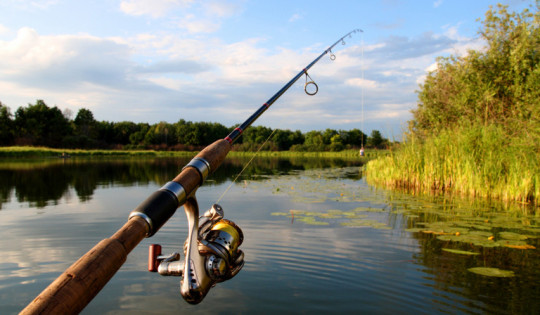Text
5 Best New Fishing Spots in America

Everything in fishing adjustments. On the minutest degree, that exchange can be as simple as fish unexpectedly turning off of green-pumpkin worms after they’d been hammering them for hours, or a gradual chew unexpectedly going bonkers earlier than a hurricane. In the grander scheme, what also can exchange is the general excellence of an entire fishery. Sometimes lakes or rivers that were warm for many years suddenly move bloodless.
Alabama
Water: Lewis Smith Lake
Targets: Largemouth Bass and Striped Bass
Alabama is home to some of the best bass lakes in the U.S., but Lewis Smith Lake wasn’t considered one of them until recently. The deep, clear lake that seemed dead for years presently has a thriving fishery thanks to the newly flourishing blueback herring population, which largemouths and stripers are chowing down on.
Alaska
Water: Situk River
Targets: Sockeye and Pink Salmon
The Situk receives much less attention than some of Alaska’s different rivers, and whilst it sees its share of site visitors during the spring and fall steelhead runs, anglers all but disappear within the summer time. Big mistake, due to the fact the Situk has robust runs of crimson and sockeye salmon expecting every person seeking solitude.
Arizona
Water: Saguaro Lake
Target: Largemouth Bass
A fish kill in 2005 decimated Saguaro’s largemouth population. However, with rejuvenated grass increase, smooth mountain water waft, and a resurgence of baitfish, the bass population has rebounded huge time. Saguaro is now a top trophy lake in Arizona, and one that the locals do not forget a hidden gem.
Arkansas
Water: Lake Ouachita
Targets: Striped Bass and Walleyes
Lake Ouachita has visible a recent increase in its shad populace, and with it came a growth inside the quantity and length of stripers and walleyes. The country also currently lowered the minimum ownership length of bass to twelve inches so one can urge anglers to fill their coolers with smaller fish and permit the bigger ones to cross.
California
Water: Skinner Reservoir
Targets: Largemouth and Striped Bass
California is thought for its massive bass lakes, however, Skinner Reservoir is a total sleeper. Local sticks seek advice from it because of the “SoCal Clear Lake” for its similarities to the well-known Clear Lake farther north. Its lunker largemouths and stripers get fats at the plentiful trout.
0 notes
Text
The potentially deadly bacterium that's on everyone's skin

Forget MRSA and E. Coli. There's every other bacterium this is turning into increasingly more dangerous because of antibiotic resistance -- and it is present on the pores and skin of all people on the planet.
A close relative of MRSA, Staphylococcus epidermidis, is a major cause of lifestyles-threatening infections after surgical operation, but it's far often omitted by way of clinicians and scientists because it's so considerable.
Researchers from the Milner Centre for Evolution at the University of Bath warn that the danger posed through this organism ought to be taken greater seriously and use more precautions for the ones at a higher hazard of contamination which is due to undergo usually operation.
They have recognized a set of sixty-one genes that permit this usually innocent skin bacterium to reason life-threatening contamination.
They hope that via understanding why some strains of S. epidermidis purpose sickness in certain occasions, they could within the destiny identify which sufferers are most vulnerable to contamination before undergoing surgery.
They took samples from patients who suffered infections following hip or knee joint substitute and fracture fixation operations and in comparing them with swab samples from the pores and skin of healthful volunteers.
They as compared the genetic variant in the complete genomes of bacteria determined in samples from diseased and wholesome people. From this, they identified 61 genes inside the ailment-causing microorganism that were not found in a maximum of the healthy samples.
Surprisingly but, there was a small number of healthful individuals who have been determined to be carrying the other deadly shape of the bacteria without understanding it.
The disease-causing genes have been found to help the bacterium develop within the bloodstream, avoid the host's immune response, make the mobile surface sticky so that the organisms can form biofilms and make the trojan horse proof against antibiotics.
The crew posted their observe in Nature Communications this week.
Professor Sam Sheppard, Director of Bioinformatics on the Milner Centre for Evolution at the University of Bath led the studies. He said: "Staphylococcus epidermidis is a lethal pathogen in undeniable sight.
0 notes
Text
Immigration to the United States changes a person's microbiome

Specialists at the University of Minnesota and the Somali, Latino, and Hmong Partnership for Health and Wellness have new proof that the gut microbiota of workers and displaced people quickly Westernize after a man's landing in the United States. The investigation of networks relocating from Southeast Asia to the U.S., distributed November 1 in the diary Cell, could give understanding into a portion of the metabolic medical problems, including stoutness and diabetes, influencing foreigners to the nation.
"We found that migrants start losing their local organisms very quickly in the wake of touching base in the U.S. and after that procure outsider organisms that are more typical in European-American individuals," says senior creator Dan Knights, a PC researcher and quantitative scholar at the University of Minnesota. "However, the new microorganisms aren't sufficient to make up for the loss of the local organisms, so we see a major generally speaking loss of decent variety."
It has appeared before that individual in creating countries have a significantly more noteworthy assorted variety of microscopic organisms in their gut microbiome, the number of inhabitants in helpful microorganisms living in people's digestion tracts, than individuals living in the U.S. "However, it was striking to see this loss of assorted variety really occurring in individuals who were changing nations or moving from a creating country to the U.S.," he says.
The exploration was led with help from - and motivated by - Minnesota's vast network of evacuees and migrants from Southeast Asia, especially the Hmong and Karen people groups, ethnic minorities that initially were from China and Burma and that today have networks in Thailand. The examination utilized a network-based participatory research approach: individuals from the Hmong and Karen people group in both Minnesota and Thailand were associated with structuring the investigation, selecting members, and teaching their networks about the discoveries.
"Stoutness was a worry that was coming up a considerable measure for the Hmong and Karen people group here. In different investigations, the microbiome had been identified with heftiness, so we needed to know whether there was possibly a relationship in outsiders and make any discoveries significant and accessible to the networks. These are powerless populaces, so we unquestionably endeavor to make the majority of our strategies as touchy to that as could be expected under the circumstances and ensure that they have a stake in the exploration," says first creator Pajau Vangay.
Knights, Vangay, and their group analyzed the gut microbiota of Hmong and Karen individuals as yet living in Thailand; Hmong and Karen individuals who had moved to the U.S.; the offspring of those foreigners; and Caucasian American controls. They likewise could pursue a gathering of 19 Karen exiles as they moved from Thailand to the U.S., which implied they could track how the displaced people's gut microbiomes changed longitudinally in their initial six to nine months in the U.S.
1 note
·
View note